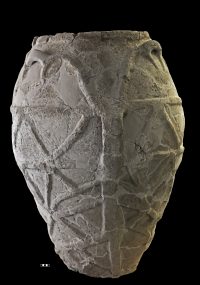 Italy’s oldest olive oil has been identified in an Early Bronze Age pot from Sicily. The vessel was discovered at the prehistoric site of Castelluccio about 30 miles west of Syracuse. It is the type site of the Castelluccio culture which flourished in southeastern Sicily between 2200 and 1800 B.C. and is known for its distinctive ceramics.
Italy’s oldest olive oil has been identified in an Early Bronze Age pot from Sicily. The vessel was discovered at the prehistoric site of Castelluccio about 30 miles west of Syracuse. It is the type site of the Castelluccio culture which flourished in southeastern Sicily between 2200 and 1800 B.C. and is known for its distinctive ceramics.
That’s why when archaeologist Giuseppe Voza found 400 fragments in an excavation at the site in the 1990s conservators at the Archaeological Museum of Syracuse took the time and effort to puzzled them all together. Their hard work restored a unique pot unlike other ceramics found at Castelluccio: an egg-shaped storage container three-and-a-half feet high decorated with rope bands intersecting in a lattice pattern and three vertical handles on each side. Voza’s team also found two basins divided by an internal septum and a large terracotta cooking plate.
“The shape of this storage container and the nearby septum was like nothing else Voza found at the site in Castelluccio,” said University of South Florida researcher Davide Tanasi.
“It had the signature of Sicilian tableware dated to the end of the 3rd and beginning of the 2nd millennium BC (Early Bronze Age).”
“We wanted to learn how it was used, so we conducted chemical analysis on organic residues found inside.”
Researchers examined organic residues of an indeterminate nature contained in the pores of the three pieces of Castelluccio pottery. They used Nuclear Magnetic Resonance (NMR) and Gas Chromatography – Mass Spectrometry (GC-MS) to analyze the residue and found oleic and linoleic acids, signatures of olive oil, in each of the three samples.
This find advances the known presence of olive oil in Italy by almost a thousand years and puts it on a par with the second earliest chemical signature of olive oil in the Mediterranean found in Chrysokamino, Crete.
“With regards to the prehistory of Italy, the only cases known of identification of chemical signatures of olive oil are those of Broglio di Trebisacce (Cosenza) and Roca Vecchia (Lecce) where large storage jars dated to the local Late Bronze Age (12th-11th century BC) tested positive.”
“In this perspective, the results obtained with the three samples from Castelluccio become the first chemical evidence of the oldest olive oil in Italian prehistory, pushing back the hands of the clock for the systematic olive oil production by at least 700 years.”
The results of the study have been published in the Royal Society of Chemistry’s journal Analytical Methods.